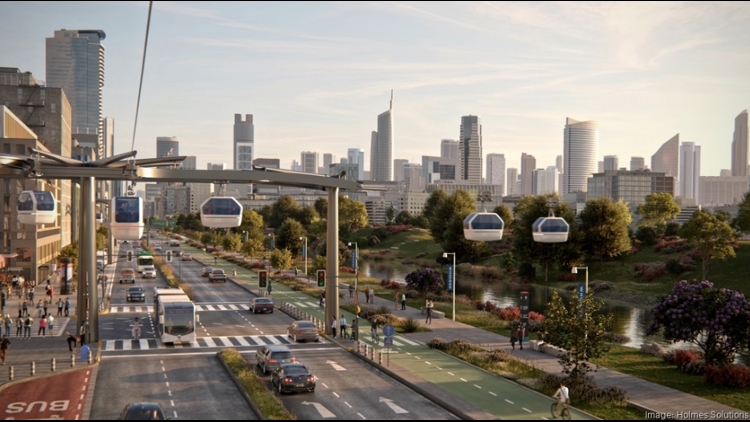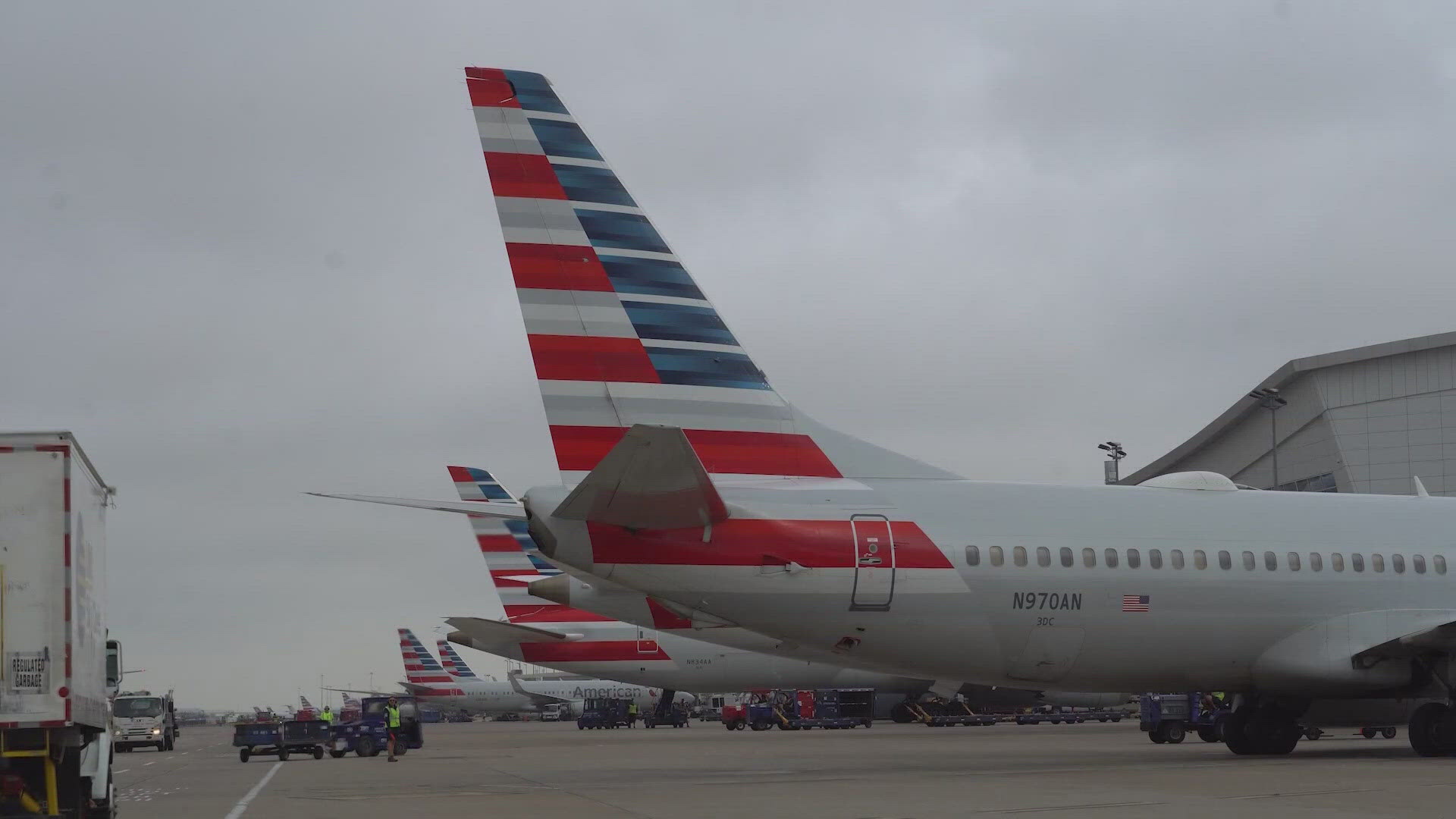DALLAS — This article was originally published by our content partners at the Dallas Business Journal. Read the original article here.
It is a universally acknowledged truth that roads in Dallas-Fort Worth are a bit congested. And it's likely to get worse, given population projections.
One technology company thinks the solution to traffic may be above ground — way above ground.
An autonomous elevated cable and rail system akin to gondolas, known as Whoosh, could be coming to one of five North Texas cities as part of a pilot program aimed at providing greater local connectivity and alleviating a bit of traffic in the Metroplex.
California-based Swyft Cities is the company behind the proposed system of on-demand, elevated trams. City leaders from Dallas, Plano, Arlington, Frisco and DeSoto have all expressed interest in getting this technology and are now in discussions with the transportation company to decide on potential locations, timelines and funding models.
North Texas cities have until the end of 2024 to submit proposals for the gondola system, and Swyft Cities plans to pick its pilot location by mid-2025.
An animated depiction of the system in action resembles a futuristic, sci-fi world — one that could become a reality in North Texas in the coming years. The program also aims to be green: the cable cars, which must be at least 16 feet in the air, are electric, meaning they emit fewer pollutants.
While some have discounted gondolas as a costly, gimmicky solution to the increasingly serious issue of congestion in North Texas, proponents suggest a gondola system could help smaller cities better manage their surging populations and related traffic concerns.
"Whoosh provides the 'perfect Uber' — fast, on-demand, nonstop trips with a great view," Jeral Poskey, CEO of Swyft Cities, said in a statement. "Vehicles are waiting for you at stations, instead of the other way around."
Swyft Cities, which operates legally as Holmes Solutions LP, has been working with the North Central Texas Council of Governments, or NCTCOG, for three years on the pilot program.
The local government association's Certification of Emerging and Reliable Transportation Technology program looks to leverage new technologies, like those pitched by Swyft, to meet the region's escalating transportation needs. CERTT launched in May 2022 and prior rounds connected cities with a hyperloop company and another prospective gondola system called JPods. NCTCOG is still working to gauge interest in these systems in the region.
"Being able to leverage private dollars is significant in our region, to be able to build out our transportation infrastructure and catch up with all of the growth that we’ve had to stave off the worst elements of congestion," said Brendon Wheeler, program manager of transportation at NCTCOG.
Reality check
Approval from NCTCOG doesn’t necessarily mean North Texans will be seeing gondola cable cars built anytime soon. The goal of the CERTT program is simply to "create that initial handshake" between local governments and companies, Wheeler said. NCTCOT wants to ensure those conversations are happening, even if the gondola system isn't constructed.
But some city officials are hopeful an aerial tramway could alleviate traffic on their roads. By 2050, North Texas is expected to eclipse 12 million residents — up from around 8.4 million today, Wheeler said. Planners say this growth will further strain the area's highways and roads.
"Our current transportation system is maxed out," Wheeler said. "So we recognize the need for more transportation solutions."
The goal of the cable car system is not to replace cars but rather to complement the existing infrastructure, including highways and rail lines meant for long distances. The tram system would be for short distances in dense areas where driving and parking a car is less efficient. The initial phase of the Whoosh system would have a radius of about 3 miles.
"If you’re in a mixed-use district-type environment, then going from one side to the other, there's no need to jump in a car or wait for a bus or something like that," Wheeler said. "You'd be able to hop on the Whoosh system and get there more directly."
Dallas Area Rapid Transit, which services 13 cities in North Texas and operates the longest light rail system in the United States, said it is aware of Swfyt Cities' gondola proposal. With new transportation solutions slowly coming on line, the local transit agency said it is important to consider how such projects would interact with existing DART services and help customers complete their respective commutes.
If approved, DART said it would "work to understand how the system would connect with its (existing) services" and how riders would navigate them.
Mixed-use developments continue to proliferate in DFW. And developers often talk of the desire for walkability and vibrant streetscapes. An overhead form of transportation could be useful to reduce congestion in these already densely packed areas, Wheeler noted.
Brian Shewski, the City of Plano's transportation engineering manager, said a gondola system could never replace roads — but that it's one possible way to mitigate local congestion.
A gondola system "is only one small component in the congestion relief toolbox that Plano is considering for the future," Shewski said in an emailed statement.
Many roads in the core of the Metroplex have reached a point where it's no longer possible to widen them, he said.
"We really need to start looking at options available to us to try to remove the traffic and motorists on the roadway system in some form or fashion," Shewski said.
This kind of innovation can happen alongside more traditional investments in transportation. Plano has been working on adding right-turn and dual left lanes to increase capacity on roads, which also improves safety for motorists.
Of course, this technology isn't an entirely new solution to getting around. Traditional gondolas, typically used in ski lifts, use a fixed car that moves back and forth along a lengthy cable and requires big engines.
"It’s really not anything so exceptionally new that it could be scary," Wheeler said. "We’re introducing some new concepts to it, and we’re making it better."
Traditional gondola systems are slow and inefficient, Shewski said. Swyft’s technology reimagines the system: each vehicle has its own engine and can transfer to different lines, making them more efficient and cost-effective. The cable cars can travel from one destination to another without stopping at intermediate stations along the way.
"What Swyft has is the equivalent to a paved roadway system in the air," Wheeler said. "It’s the vehicles themselves that move along in such a way that they can build a grid pattern, much like a roadway grid."
Government leaders intend to implement the technology in a location that makes sense. Plano city officials proposed the Legacy Business Park area, which extends along Legacy Boulevard between Parkwood Boulevard and Communications Parkway, as a place worth examining.
"From a density standpoint, it is only exceeded by downtown Dallas," Shewski said of Legacy Business Park. "It is a hot mess of congestion."
Cost, safety concerns
Not everyone is thrilled. In online forums, some critics have emphasized the need for upgrades to the region’s roads and related infrastructure. Others have expressed concerns about the cost of such a project and wondered whether it would place a burden on taxpayers.
A July 9 editorial by the Dallas Morning News contended that gondolas are costly, inefficient and typically work best in regions of high elevations — unlike mostly flat North Texas.
"Planners should work on how to move large numbers of people, not boutique alternatives more suited for tourism and sightseeing than mass transportation," the newspaper's editorial board wrote.
During a March 2023 Plano City Council meeting, Shewski said that private equity would fund the entire project. Council members approved submitting an application to Swyft Cities in the same meeting.
At the time, Council Member Anthony Ricciardelli said he was in favor of exploring the transit technology but had some concerns about safety on the gondolas, which he noted are enclosed spaces used by a small number of people. Shewski said Swyft Cities was looking into adding facial recognition technology to deter any potential bad actors.
So far, Plano has not made any financial commitments for an elevated cable car system.
Cable cars can hold up to five passengers each and are compliant with disability access. Fare for riders will depend on location and use; some districts could opt to provide free transit while others serving daily commuters may implement a "modest fare," Poskey said in a statement.
The total cost of the North Texas pilot system is expected to be around $30 million to $50 million. Swyft Cities is examining a variety of funding options, including federal grants, public-private partnerships and private investment, according to Poskey.
"As the region is growing at such an exponential rate, faster than any large metro in the U.S., we really have the need to do it well, avoid the mistakes and missteps of other regions and do it in a way that provides access to the local community," Wheeler said.



